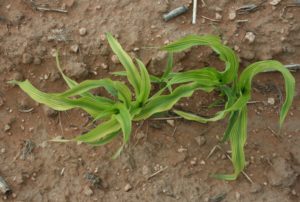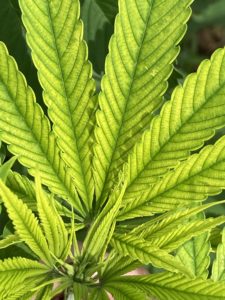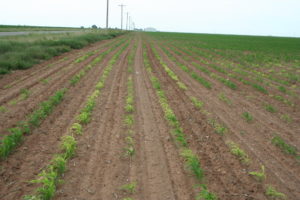Dr. Calvin Trostle, Extension Agronomy, TAMU Dept. of Soil & Crop Sciences, Lubbock, (806) 746-6101, ctrostle@ag.tamu.edu;
June 9, 2021
Much of Texas has experienced heavy rains, cloudy conditions, and water-logged soils since early May. Many crops will show signs of nutrient deficiency under such conditions. These include iron (Fe) and nitrogen.
Symptoms for N and Fe nutrient deficiency may be confused with each other. Nitrogen is mobile within the plant. N deficiency leaf symptoms are expressed in older leaves. This is usually a broad general pale color of light green trending toward yellowish. To help you remember this, recall that nitrogen is also mobile within the soil.
In contrast, iron deficiency is found in the youngest leaves. Iron is immobile in the plant, which is like iron in soils. It does not move. It is tied up by oxides of calcium (high pH) or aluminum (low pH, or acid soils). When iron becomes available again, newly emerging leaves will again be dark green. Older chlorotic leaves will not green up unless they receive a direct foliar feed.
Iron is often among the easiest nutrient deficiencies to diagnose. It has distinct “interveinal chlorosis.” The leaf mid-rib and veins remain green and the tissue between the veins is yellow (Figs. 1-3).
Grain sorghum in more susceptible to iron deficiency than most crops (Fig 1). The iron uptake mechanism at the root relies on a plant-generated acid to lock with iron and facilitate transfer into the root. Other grasses do this better than sorghum. When you couple a poor iron uptake mechanism with high pH soils or wet/water-logged soils, symptoms are more likely to occur relative to other grasses.
Broadleaf crops are subject to iron deficiency as well. Peanuts, for example, are more prone to waterlogged conditions than being absolute poor at iron uptake (Fig. 2). When wet conditions are coupled with high pH leaves can be nearly bleached out (light yellow to almost white).
Now that industrial hemp may be farmed in Texas there are numerous reports of iron deficiency in hemp as well (Fig. 3).
Managing fields that have been prone to heavy rains and extended wet weather may be as simple as waiting for the field to dry out and sunshine to return. As the soil dries and root volume continues to expand, many crop plants will grow out of iron deficiency.
A major concern, however, with iron is the potential effect on reproductive growth. As noted above, iron deficiency affects the youngest tissue on a stalk or branch. That is where reproductive growth for a flower and usually a seed occurs. Pronounced and prolonged iron deficiency can lead to stunting and reduced yield.
Fig. 1. Iron deficiency in grain sorghum expressing interveinal chlorosis. These smaller plants do not yet have an expansive root volume. Note also chalky caliche (calcium carbonate) fragments on the soil surface. This indicates likely pH > 7.8 to 8.3, which curtails iron uptake. Notice the older smaller leaves are mostly solid green.
Fig. 2. Strong iron deficiency in peanut on younger leaves. Deficiency symptoms have almost surpassed interveinal chlorosis to solid yellow. Peanuts due to a taproot (deeper roots) seem more able to grow their way out of iron deficiency, but prolonged deficiency will limit yield.
Fig. 3. A newcomer to Texas crops, industrial hemp in 2021’s May rainy spell has resulted in widespread iron deficiency. Evidence already demonstrates hemp’s ability to grow out of the deficiency when dry, hot weather returns. Still, moderate symptoms may call for the temporary aid of applying iron until we learn more about hemp in Texas and whether iron deficiency limits growth and yield.
Possible Solutions to Address Iron Deficiency
Field situations of broader iron deficiency may call for remediation (Fig. 4). Because iron is relatively insoluble in soils and iron chelates are expensive, it is not normally feasible to soil apply iron, especially when a moderate to severe deficiency must be relieved. The most feasible means of providing iron through the soil is manure or its compost. That is a long-term approach. It depends on source materials being readily available (chicken farms, feedlots, dairies, etc.). Soil-applied iron chelates are generally not effective as the chelate itself will decompose over time.
Most soil tests will flag Fe < 4 ppm as deficient. As there are no economical sources of soil-applied Fe available, the only options for correcting immediate Fe deficiencies are foliar Fe sprays in-season. If iron chlorosis has been observed during previous years in a field, iron fertilizer materials may be applied preemptively to the foliage through multiple sprayings early in the season. Table 1 gives suggested foliar treatments to correct iron.
Sorghums and Iron Deficiency
Grain sorghum and sorghum family forages are by far the most likely Texas crop to encounter iron deficiency. Among forages, hybrid pearl millet can be substituted for grain sorghum as HPM has different iron uptake mechanism. It can grow well on moderately alkaline, high pH soils were iron would limit sorghums. For further information about iron in grain sorghum consult ‘Correcting Iron Deficiencies in Grain Sorghum’ L-5155, from Texas A&M AgriLife Extension, http://publications.tamu.edu/ (see the ‘Corn & Sorghum’ section).
Fig. 4. Grain sorghum in low lying area of the field extending to the right for about 100 acres may benefit from an iron application. This dryland High Plains crop may not have the yield potential to justify an application of ~$15 per acre or more.
Table 1. Suggested sources, rates, and timing of iron foliar sprays.
| Deficiency | Product* | Product/100
gals water |
Product/
Acre |
Timing |
| Iron | Iron (ferrous**) sulfate (20% Fe) | 20 lbs (2.5% solution) | 1 lb. then 2-3 lbs. | For early symptoms, apply 10-14 days after emergence – 5 gals/A over crop row. Follow w/ additional applications @ 10-14 day intervals @ 10-15 gals/A |
| Iron | Iron chelate (10% Fe) | 8 lbs. (1%) | 0.4-0.5 lbs | Same as above |
*Include a surfactant or other wetting agent. Product composition may vary. Select similar products or adjust mixing ratios to achieve comparable rates of nutrient application. Source: Updated information based on research results and recommendations through the Texas A&M AgriLife Extension Service Soil, Water and Forage Testing Laboratory (http://soiltesting.tamu.edu).
**Ferrous iron is Fe2+, the reduced form of iron. When ferrous iron comes in contact with soil it will oxidize to highly insoluble ferric iron, Fe3+. The ferrous form is much more soluble and more readily taken up by plants through the leaf surface.



